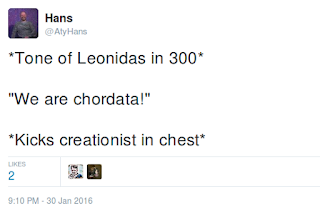We are chordata!
After seeing this Youtube video by AronRa, I was inspired to make a related tweet. You know how it is.

[link]
As you can see, it's not a very popular tweet. Still, it's what this post is about; Human taxonomy.
We are classified, by scientists, according to the similarities and differences we share with other organisms. This classification is done with the help of different fields within biology: embryology, morphology, genetics, etc.
Ever since Linnaeus, thousands of biologists have been working on his taxonomic framework, expanding it and improving it. Thanks to the advent of DNA sequencing, phylogenetic trees are used to improve and refine it even further. No organism has ever been found on earth which doesn't have DNA. All organisms on earth have DNA sequences in common with each other.
The top most global classification of humans is Neomura. We belong to a group of organisms that have glycoproteins. This is our Superdomain. We are neomuran. We share this classification with Archaea, a type of bacteria. [There are bacteria that do not share this classification with us].
The second most global classification of humans is Eukaryota. We belong to a group of organisms that have membrane-bound organelles. This is our Domain. We are eukaryotes. We share this classification with plants.
The third most global classification of humans is Opisthokonta. We belong to a group of organisms that have a flagellum in our reproductive cells. We are opisthokonts. We share this classification with fungi.
The next classification is the Superkingdom Holozoa. This excludes fungi. We are Holozoa. We share this classification with sponges.
Another group classification is Filozoa. These have cells with threadlike projections. We are Filozoa. We share this classification with some amoebas.
We belong to the Kingdom Animalia. Animals can move freely. We are animals. We share this classification with jellyfish.
Subkingdom Eumetazoa. Animals in this group have cell tissue and neurons. We are Eumetazoa. We share this classification with sea anemones.
Superphylum Bilateria. As the name indicates, animals in this group have bilateral symmetry. Basically, we have similar left - right sides as well as not similar up - down and front - back. We are Bilateria. We share this classification with flatworms and insects.
The Deuterostomes have both a mouth and an anus. (Some Flatworms have only a mouth, others have a mouth and an anus, others still have multiple anuses... the more you know). We are Deuterostomes. We share this classification with sea cucumbers.
Phylum Chordata. Finally we arrive at the level of my tweet. Chordates have a hollow dorsal nerve cord. We are Chordates. We share this classification with lancelets, fish-like animals that hardly have a brain.
Shall we continue?
We are Vertebrata (backbones e.g. lampreys)
We are Gnathostomata (jawed vertebrates e.g. fish)
We are Sarcopterygii (enamel on teeth e.g. lobe-finned fish)
We are Rhipidistia (bones in the skull, details of the skeleton e.g. coelacanth)
We are Tetrapoda (four-limbed vertebrates e.g. frogs, snakes, birds, dinosaurs)
We are Synapsids (openings in skulls. All mammals are synapsids. e.g. platypus)
We are Mammalia (mammary glands e.g. rodents)
We are Theria (give birth to life young e.g. marsupials)
We are Eutheria (features of the feet, ankles, jaws and teeth. All placental mammals)
We are Boreoeutheria (placental mammals e.g. moles)
We are Euarchontoglires (based on DNA e.g. treeshrews)
We are Primatomorpha (binocular vision e.g. flying lemur)
We are Primates (relative large brains e.g. bushbabies)
We are Haplorhini (dry nosed primates e.g. tarsiers)
We are Simiiformes (Simians e.g. gibbon)
We are Catarrhini (nostrils that face downwards e.g. macaque)
We are Hominoidea (Apes e.g. orangutans)
We are Hominidae (Great Apes e.g. gorillas)
We are Homininae (Great Apes except orangutans)
We are Hominini (except gorillas)
We are Hominina (except chimps)
We are Homo (descendants of Australopithecus e.g. Homo Habilis)
We are Homo sapiens (modern human species e.g. Homo sapiens idaltu)
We are Homo sapiens sapiens, that's our subspecies.
Source: @karlmeyer
As you can see, our taxonomy and our shared DNA with these other lifeforms point to a shared ancestry of all life on earth.
I invite you to play with the timetree.org website to see the scientific studies associated with all this.
Edits - Added the Prentice Hall image at the suggestion of @KittenKoder and the image from @karlmeyer
Moved 'insects' to the correct level (Bilateria) at the correction of @kaimatai
I recommend reading this BBC article.



Comments
Post a Comment